Sustainability at the Zoo
Making responsible choices and taking action to conserve natural resources are a way of life here at Point Defiance Zoo & Aquarium (PDZA). We strive to operate at the highest level of sustainability. This means conserving resources to allow future generations to meet their needs.
Committing to a green future
We’re certified a top-level EnviroStars Champion by the City of Tacoma.
Our Sustainability Plan, created by the Zoo’s Green Team, includes bi-annual goals with a long term goal for 2025 for carbon footprint/energy; water, waste and hazardous waste; construction/purchasing; and staff and guest engagement.
What We do
REDUCE ~ REUSE ~ RECYCLE
Recycling is a great way to make a difference locally and globally – but reducing consumption and reusing materials is even better. Here’s what we do at the Zoo.
REDUCING AT THE ZOO
- We double-side office printing.
- All office paper is 100% recycled.
- Our paper towels, toilet paper, garbage bags and toilet seat covers are made from 30%-70% recycled materials.
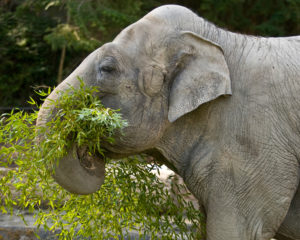 REUSING AT THE ZOO
REUSING AT THE ZOO
- In the office, we use scratch paper for notes and reuse file folders.
- Older office furniture goes where it is needed.
- Staff uniforms are reused until they can’t be worn anymore.
- When we clean, we use micro-fiber cloths on our windows/mirrors instead of paper towels – fewer chemicals, and they work great!
- We also buy mop heads that last for many washings.
- When we garden, we use branch trimmings for animal perches and shelter.
- Plants around the zoo are used for animal browse (edible twigs, leaves, and shoots) – like bamboo for our elephant. Growing our own browse means that we don’t need to bring it in from somewhere else, which helps reduce our carbon footprint.
- We use bamboo stems for staking small plants for support. Larger stems are used to build fences and gates around the Zoo.
- Instead of buying “beauty bark,” we collect wood chips from local tree companies to use in our landscapes. These chips also help keep the weeds down, maintain the right soil temperature for plant roots, and hold water in the soil longer so less watering is needed. When the chips break down, they provide nutrients to the plants.
What can be reused in your life?
RECYCLING AT THE ZOO
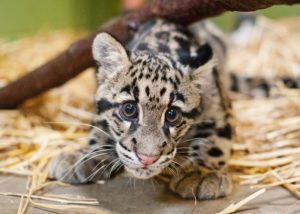 We recycle plastic wood shavings bags, straw, hay bale twine, non-rechargeable batteries, cell phones, construction materials and much more!
We recycle plastic wood shavings bags, straw, hay bale twine, non-rechargeable batteries, cell phones, construction materials and much more!
WE SAVE POWER
- We replaced old water recirculation pumps with more
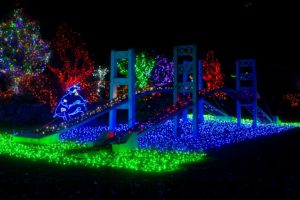 efficient pumps at our Rocky Shores exhibit, which only run at full speed when necessary. This reduced our power consumption by 300,000 kilowatt hours.
efficient pumps at our Rocky Shores exhibit, which only run at full speed when necessary. This reduced our power consumption by 300,000 kilowatt hours. - We installed three flux valves in the aquarium water exchange system, reducing power use by 30-40%.
- We invested $140,000 to replace all Zoo lighting (including Zoolights and aquariums) with LED-equivalent – this reduced our power use by over 90%. Wow!
- We installed 90%-effective HVAC (heating, ventilation, and air conditioning) systems, and added timers to heaters for animal habitats, reducing power use by 40%.
- We also added blankets and timers to water heaters, which insulate the heaters and turn off tanks when the Zoo is closed.
- Our diesel boiler was switched to a natural gas boiler. Now we buy about 5,200 fewer gallons of fuel per year. The new boiler is 95% efficient, while the old one was only about 78%.
- We installed motion sensor lighting, and buy energy-efficient appliances when we can.
WE SAVE WATER
- We converted all urinals and toilets to use less than
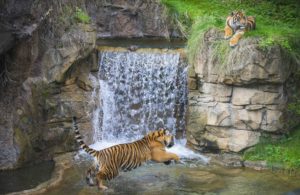 1.5 gallons of water per flush, rather than 5
1.5 gallons of water per flush, rather than 5 - We also installed motion sensors at hand-washing sinks so that water can’t be left on, and rain sensors to our garden watering systems to help prevent overwatering.
- Soaking pools and waterfalls turn off automatically when animals are off exhibit.
- We plant native and drought-tolerant plants that need less water, and mulch them to retain soil moisture.
- We also collect and use rainwater.
AND WE COMPOST!
- Paper towels from staff restrooms
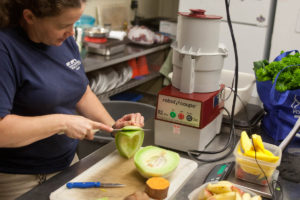
- Kitchen scraps from the Plaza Cafe
- Animal bedding (mostly cedar shavings, straw and poop)
- Un-eaten produce (fruits and veggies)
- Branches and leaves trimmed from the Zoo’s gardens
Take Action
- Turn off your engine! Notice our Idle Free Zoo signs at loading areas? Turning off your engine when waiting for 30 seconds or more is better for your engine and the planet.
- Green your ride: An electric car plug-in station is available in the parking lot behind our Elephant Barn.
- Ride a bike: Bike racks are available to the left of the Zoo’s main entrance, next to the Education Center.
- Recycle! Bring any recyclables back home for proper disposal.
- Take transit: Pierce Transit bus stop for route 11 is located just down the street near the entrance to Point Defiance Park.
- Recycle your old holiday lights by bringing them to the Zoo in November and December each year.